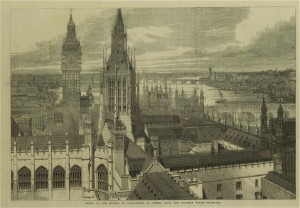Up until the 1940s the Palace of Westminster was ventilated using a stack ventilation system that originated in the mid-nineteenth century and was technically refined over a period of ninety years, involving several design modifications. It was a nineteenth century example of a mixed mode system, integrating natural and mechanical strategies. Hot air was drawn out of the building using buoyancy driven stack ventilation system, which exploited the waste heat from bodies, smoke (from fire places, boilers and kitchens), gas lighting and the heating. The air flow was assisted by steam jets or coke fires, and after 1904, by means of electric fans. The historic stack system is no longer operational but extensive archival evidence has survived and allows reconstructing the original system in great detail as well as analysing its performance. This project is based on extensive archival research conducted at the Smithsonian Institute, British Library, Parliamentary, National, London Metropolitan Archives and the libraries at UCL and the University of Cambridge. This material has not been studied by historians in any depth before, and this project has shown how primary source material can be used to reconstruct the design and performance of the historic system in great detail. In addition, modern technology and our current scientific understanding also enables to re-vitalize and improve the historic system. This possibility is investigated as part current inquiries into sustainable environmental design strategies for the refurbishment of the Palace. The primary research objectives of this project are to regain a critical understanding of the original system, how it was operated and performed under different conditions, using a combination of archival research and technical analysis. Since the start of this project in September 2011 the focus has been on historical research, involving extensive archival research, which included the study of the original project correspondence, drawings, sketches, measured data and scientific reports. An analysis based on historic data, both quantitative and qualitative, has provided detailed insights the system’s actual performance from the mid-nineteenth century through to the 1940s. Archival evidence also illuminated some of the technical issues encountered and the measures taken by the Victorians to improve its performance, including numerous technical modifications and changes to the environmental monitoring and control procedures. The methods used by the Victorians in the development and testing of the system are also studied. The research project focuses on four main areas:
(1) reconstruction of the design and management of the historic system
(2) analysis of the design development process and the original environmental design objectives
(3) study of the post-occupancy history, which includes a detailed analysis of the system’s performance as well as the various technical refinements made throughout its lifetime
(4) Design-led studies into potential strategies for re-vitalizing parts of the historic system as part of a sustainable ventilation strategy for the Houses of Parliament.
This project is co-ordinated by Dr. Henrik Schoenefeldt and in 2013 was extended to include collaborations with the Parliamentary Design Authority.
The current focus of this collaboration is on ventilation of the House of Lords debating chamber, which includes a detailed reconstruction and performance analysis of the historic system, based on archival research, computer fluid dynamic simulations and surveys of the existing chamber. This analysis is used to re-valuating the effectiveness of the historic system relative to nineteenth century and modern benchmarks of energy efficiency, thermal comfort and air quality. The findings of a preliminary study has been outlined in a report entitled First Report on the Victorian ventilation system of the House of Lords – Its design and evolution, 1839-54, which was submitted in January 2014. The report focuses on the evolution of the original Victorian system in the House of Lords from the 1840s till 1854, with a particular focus on the design introduced by Charles Barry’s team in 1846 and its subsequent remodelling. This will be followed by design-led research, interrogating various alternative scenarios for revitalizing optimizing the performance of the historic system.
To read more please visit Dr Schoenefeldt’s staff page.


